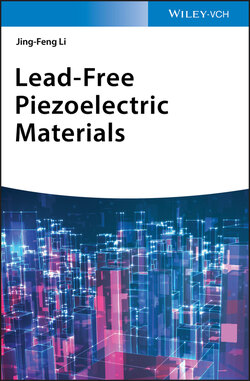Читать книгу Lead-Free Piezoelectric Materials - Jing-Feng Li - Страница 28
2.5 BiFeO3
ОглавлениеBismuth ferrite (BiFeO3) possesses a rhombohedrally distorted perovskite structure as shown in Figure 2.6, which can be denoted as a pseudocubic structure with lattice parameter a = 0.396 nm and α = 89.6° [45]. BiFeO3 is the only room‐temperature multiferroic material with coexisting ferroelectric and magnetic properties in a single compound [46]. Extensive studies have been conducted on this compound in the form of thin films, which are expected to open up new applications [47]. As reported in the epitaxial thin films, BiFeO3 has a high Curie point (Tc ~ 830 °C) and large remnant polarization (Pr ~ 100 μC/cm2) at the same time [47]. In addition, the cost of resource is low because of the earth abundance of the constituent elements. Most importantly, BiFeO3 is a lead‐free ferroelectric compound where Bi has a similar electronic structure with Pb. Therefore, recently, increasing attention has been paid to the development of BiFeO3‐based lead‐free piezoelectrics.
However, BiFeO3 and BiFeO3‐based ceramics have high leakage current issues, mainly induced by defects and secondary phases, which hinder the poling process required for piezoelectric ceramics [48]. To resolve this problem, extensive investigations have been conducted based on chemical modifications to BiFeO3 [49]. In 2008, Takeuchi and coworkers introduced another rhombohedral–orthorhombic (R–O) MPB that was formed by A‐site doping with 14% Sm in BiFeO3 films grown on SrTiO3. The piezoelectric coefficient d33 near this MPB could reach 110 pm/V [50]. This report stimulated many studies about Sm‐doping on BiFeO3, and the addition of other rare earth elements were also investigated to promote the piezoelectricity and ferroelectricity. For example, a large piezoelectricity (d33 ≈ 50 pC/N) was reported in Sm and La co‐doped BiFeO3 ceramics [51]. Higher properties are obtained in BiFeO3 ceramics with the addition of ABO3. In a study by Lee et al., excellent piezoelectric properties with a Curie temperature above 400 °C were reported in BiFeO3–BaTiO3 ceramics with the addition of either Bi1.05GaO3 or Bi1.05(Zn0.5Ti0.5)O3 fabricated in a sintering‐and‐quenching process [52]. Such a special process has proved to effectively suppress the formation of point defects and secondary phase and thereby reduce the high current leakage [53].
Figure 2.6 Crystalline structure of BiFeO3.
The main applications of BiFeO3‐based ceramics are considered to be high‐temperature piezoelectric sensors, but their lower usage temperatures should be lower as compared with bismuth layer‐structured ferroelectric ceramics (BLSFs). Nevertheless, BiFeO3‐based ceramics have the potentials to achieve much higher piezoelectric coefficients, so their applications can be extended to broader areas including piezoelectric actuators and transducers at middle and high temperatures.
